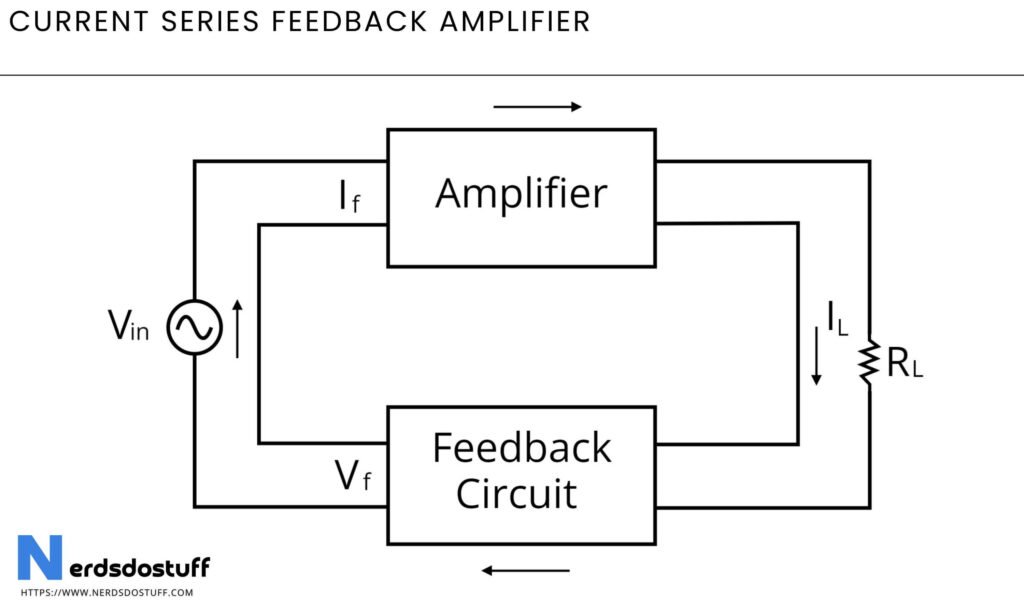What is Current Series Feedback Amplifier ?
A current series feedback amplifier is a type of electronic amplifier configuration in which feedback is applied by sampling a portion of the output current and feeding it back to the input of the amplifier. Unlike traditional voltage feedback amplifiers, which use the output voltage for feedback, current series feedback amplifiers regulate and control the output by monitoring the output current. This design enhances performance by offering advantages like improved bandwidth, increased linearity, and reduced output impedance. Current series feedback amplifiers are often employed in applications where precise current control, low distortion, and extended frequency response are crucial, such as in audio and communication systems.
Why Current Series Feedback Amplifier is used ?
Current series feedback amplifiers are commonly used in electronic circuits due to their advantages in terms of performance and stability. In a current series feedback configuration, the feedback network is connected in series with the input current to the amplifier. This design offers several benefits, one of which is improved linearity. By controlling the input current, the amplifier operates in a more linear region of its transfer characteristic, reducing distortion in the output signal. This is particularly important in applications where accurate signal reproduction is crucial, such as in audio amplifiers or communication systems.
Another key advantage of current series feedback amplifiers is enhanced bandwidth. The feedback network helps to stabilize the amplifier’s frequency response, allowing it to maintain a consistent gain over a wider range of frequencies. This is essential in applications where a flat and predictable frequency response is required, such as in data communication systems or high-frequency signal processing.
Current Series Feedback Amplifier Circuit Diagram

Working of Current Series Feedback Amplifier
- Basic Configuration:
- The amplifier typically consists of an input stage and an output stage.
- The input stage amplifies the input signal.
- The output stage provides the final amplified output.
- Feedback Network:
- In a current series feedback amplifier, the feedback is achieved by connecting a resistor (Rf) in series with the load (usually connected to the collector or drain of the output transistor).
- The feedback network controls the amount of current that is fed back to the input stage.
- Current Feedback:
- The feedback current is proportional to the output current.
- As the output current increases or decreases, the feedback current through the resistor also changes.
- Controlled Voltage Across Load:
- The voltage across the load is directly influenced by the feedback current.
- The feedback resistor (Rf) converts the output current to a voltage drop across itself.
- Input Signal Amplification:
- The input signal is applied to the input stage of the amplifier.
- The input stage amplifies the input signal, and this amplified signal is then used to control the output current.
- Stabilization:
- The current feedback helps in stabilizing the amplifier by controlling the gain and minimizing distortion.
- It provides better bandwidth and reduces sensitivity to variations in the characteristics of the active components.
Applications of Current Series Feedback Amplifier
- Operational Amplifiers (Op-Amps):
- Current series feedback amplifiers are frequently used in operational amplifiers (op-amps). Op-amps play a crucial role in analog signal processing, providing functions like amplification, filtering, and signal conditioning. The current series feedback configuration helps to stabilize the op-amp and achieve precise control over the gain and other parameters.
- Audio Amplifiers:
- In audio systems, current series feedback amplifiers can be employed for audio signal amplification. These amplifiers help in achieving high-fidelity audio reproduction by providing a linear response to the input signals. The stability and controlled gain characteristics make them suitable for use in audio amplification circuits, such as those found in stereo systems, audio receivers, and power amplifiers.
- Instrumentation Amplifiers:
- Instrumentation amplifiers are commonly used in measurement and instrumentation systems where high accuracy and low noise are critical. Current series feedback amplifiers can be utilized in the construction of instrumentation amplifiers to provide precise amplification of small signals, making them suitable for applications such as sensor interfaces, strain gauge amplifiers, and other measurement devices.
- Communication Systems:
- Current series feedback amplifiers are employed in various stages of communication systems, including RF (Radio Frequency) and IF (Intermediate Frequency) amplifiers. These amplifiers contribute to achieving the required gain and bandwidth characteristics essential for reliable signal processing and transmission in communication devices, such as radio receivers, transceivers, and transmitters.
